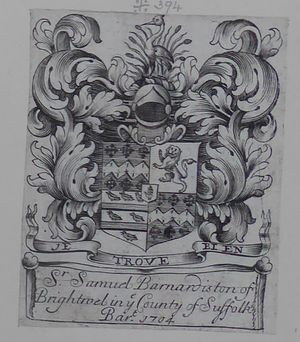Difference between revisions of "Samuel Barnardiston 1620-1707"
| (13 intermediate revisions by 3 users not shown) | |||
| Line 1: | Line 1: | ||
| − | === | + | __NOTITLE__ |
| + | ===Sir [[name::Samuel]] [[name::BARNARDISTON]], 1st [[personal title::bart]], [[date of birth::1620]]-[[date of death::1707]]=== | ||
| + | [[file:P1120461(2).JPG|thumb|Samuel Barnardiston's bookplate (British Museum Franks Collection *394)]] | ||
| + | ====Biographical Note==== | ||
| + | Third son of [[family::Sir Nathaniel Barnardiston]], of [[location::Kedington, Suffolk]], a leading puritan MP and landowner, and member of a prominent Suffolk family whose members included Sir [[crossreference::Thomas Barnardiston 1674-1700|Thomas Barnardiston]], 3rd baronet, (1674-1700) and [[crossreference::Ann Barnardiston 1624-1701|Ann Barnardiston]] (d.1701). He went into mercantile trade in [[location::London]], acting during the 1640s as an agent for the [[organisations::Levant Company]], through which he became wealthy, purchasing his own estate at [[location::Brightwell]] near [[location::Ipswich]], where he erected a large house. He was in [[location::Smyrna]] in the late 1640s. He was knighted in 1660 and made a [[personal title::baronet]] in 1663. He was deputy governor of the [[organisations::East India Company]] 1668-70, and involved in a major dispute between the Lords and the Commons concerning the Company's affairs. He became [[occupation::MP]] for [[location::Suffolk]] in 1673, though the election was contested, leading to lengthy legal proceedings. His strong puritan sympathies led him to support the anti-Catholic exclusion cause in the late 1670s and 1680s and he helped (as jury foreman) in the 1681 acquittal of [[associates::the Earl of Shaftesbury]]; during the 1680s he was himself imprisoned and fined for libel, though eventually released and vindicated. He continued to serve as an [[occupation::MP]] throughout the reign of [[associates::William III]]. | ||
| − | ==== | + | ====Books==== |
| − | + | The extent of his library is not known; there is no mention of books in his will, and his estate passed to a nephew. | |
====Characteristic Markings==== | ====Characteristic Markings==== | ||
| − | + | Towards the end of his life, Barnardiston began using an engraved armorial bookplate, dated 1704 (Franks *394; the original plate was subsequently re-engraved and redated 1728 for the use of his descendent the 5th baronet). | |
====Sources==== | ====Sources==== | ||
<div id="sourcelist"> | <div id="sourcelist"> | ||
| + | *[http://www.historyofparliamentonline.org/volume/1690-1715/member/barnardiston-sir-sir-samuel-1620-1707 History of Parliament]. | ||
*Blatchly, J. ''Some Suffolk and Norfolk ex-libris'', 2000. 9. | *Blatchly, J. ''Some Suffolk and Norfolk ex-libris'', 2000. 9. | ||
*Gambier Howe, E. R. J. ''Franks bequest: catalogue of British and American book plates bequeathed to the ... British Museum''. London, 1903. 1525/*120/*156/*161-2/*368. | *Gambier Howe, E. R. J. ''Franks bequest: catalogue of British and American book plates bequeathed to the ... British Museum''. London, 1903. 1525/*120/*156/*161-2/*368. | ||
| Line 16: | Line 21: | ||
{{DEFAULTSORT:Barnardiston, Samuel, Sir}} | {{DEFAULTSORT:Barnardiston, Samuel, Sir}} | ||
[[Category:Gentry]] | [[Category:Gentry]] | ||
| − | |||
[[Category:Bookplates and Labels]] | [[Category:Bookplates and Labels]] | ||
| − | |||
[[Category:Members of Parliament]] | [[Category:Members of Parliament]] | ||
| + | [[Category:All Owners]] | ||
Latest revision as of 08:29, 23 June 2022
Sir Samuel BARNARDISTON, 1st bart, 1620-1707
Biographical Note
Third son of Sir Nathaniel Barnardiston, of Kedington, Suffolk, a leading puritan MP and landowner, and member of a prominent Suffolk family whose members included Sir Thomas Barnardiston, 3rd baronet, (1674-1700) and Ann Barnardiston (d.1701). He went into mercantile trade in London, acting during the 1640s as an agent for the Levant Company, through which he became wealthy, purchasing his own estate at Brightwell near Ipswich, where he erected a large house. He was in Smyrna in the late 1640s. He was knighted in 1660 and made a baronet in 1663. He was deputy governor of the East India Company 1668-70, and involved in a major dispute between the Lords and the Commons concerning the Company's affairs. He became MP for Suffolk in 1673, though the election was contested, leading to lengthy legal proceedings. His strong puritan sympathies led him to support the anti-Catholic exclusion cause in the late 1670s and 1680s and he helped (as jury foreman) in the 1681 acquittal of the Earl of Shaftesbury; during the 1680s he was himself imprisoned and fined for libel, though eventually released and vindicated. He continued to serve as an MP throughout the reign of William III.
Books
The extent of his library is not known; there is no mention of books in his will, and his estate passed to a nephew.
Characteristic Markings
Towards the end of his life, Barnardiston began using an engraved armorial bookplate, dated 1704 (Franks *394; the original plate was subsequently re-engraved and redated 1728 for the use of his descendent the 5th baronet).
Sources
- History of Parliament.
- Blatchly, J. Some Suffolk and Norfolk ex-libris, 2000. 9.
- Gambier Howe, E. R. J. Franks bequest: catalogue of British and American book plates bequeathed to the ... British Museum. London, 1903. 1525/*120/*156/*161-2/*368.
- Jr, James S. Hart. "Barnardiston, Sir Samuel, first baronet (1620–1707), politician." Oxford Dictionary of National Biography.
